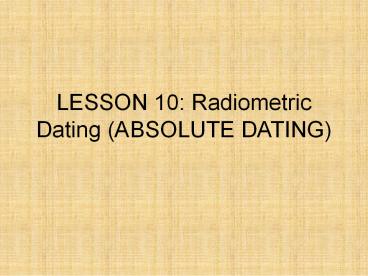LESSON 10: Radiometric Dating (ABSOLUTE DATING) - PowerPoint PPT Presentation
Title: LESSON 10: Radiometric Dating (ABSOLUTE DATING)
1
LESSON 10 Radiometric Dating (ABSOLUTE DATING)
2
What are Isotopes?
- Same number of PROTONS
- Different number of NEUTRONS
- C12
- C14
3
Why are some Isotopes unstable?
- Elements are composed of one or more naturally
occurring isotopes, which are normally stable.
Some elements, however, have unstable
(radioactive) isotopes - Unstable atoms are radioactive because their
nuclei change or decay by spitting out radiation,
in the form of particles or electromagnetic
waves. - Radioactive isotopes decay so slow that a
fraction still remains since they were created
(examples uranium, potassium) - About 339 isotopes occur naturally on Earth, of
which about 79 are stable
4
What Isotopes are used for Dating Fossils?
Technique Range (in yrs) Daughter Mol. Half life Range (in yrs) Daughter Mol. Half life Range (in yrs) Daughter Mol. Half life What they are Used for
lead 210 Pb210 1 150 Bismuth 210 22.3 year lake and ocean sediments, glacial ice
carbon 14 C14 1 60,000 Nitrogen 14 5,730 yrs previously living things
Uranium 235 U235 1 400,000 Lead 207 704 million yrs bone, teeth, coral, shells, eggs
Potassium 40 K40 10,000 3 billion Argon 40 1.25 billion minerals, igneous rocks
Uranium 238 U238 1 million - 4.5 billion Lead 206 4.5 billion yrs minerals, igneous rocks
Rubidium 87 60 million 4.5 billion Strontium 87 48.8 billion yrs minerals, igneous rocks
5
What is Radiometric Decay?
- Naturally-occurring radioactive materials break
down into other materials at known rates. - Radioactive parent elements decay to stable
daughter elements. - Each radioactive element decays at its own nearly
constant rate. Once this rate is known,
geologists can estimate the length of time over
which decay has been occurring by measuring the
amount of radioactive parent element and the
amount of stable daughter elements. - Each radioactive isotope has its own unique
half-life - time it takes for half of the radioactive element
to decay
6
RADIOACTIVE DECAY GRAPH
7
What is Carbon Dating?
- Method that uses the naturally occurring 14C
isotope to determine the age of carbonaceous
materials up to about 70,000 years old. - One of the frequent uses of the technique is to
date organic remains from archaeological sites.
Plants fix atmospheric carbon during
photosynthesis, so the level of C14 in living
plants and animals equals the level of C14 in the
atmosphere.
8
How does Carbon Dating Work?
- Cosmic rays from the sun strike Nitrogen 14 atoms
in the atmosphere and cause them to turn into
radioactive Carbon 14, which combines with oxygen
to form radioactive carbon dioxide. - Living things are in equilibrium with the
atmosphere, and the radioactive carbon dioxide is
absorbed and used by plants. The radioactive
carbon dioxide gets into the food chain and the
carbon cycle. - All living things contain a constant ratio of
Carbon 14 to Carbon 12. (1 in a trillion). - At death, Carbon 14 exchange ceases and any
Carbon 14 in the tissues of the organism begins
to decay to Nitrogen 14, and is not replenished
by new C-14. - The change in the Carbon 14 to Carbon 12 ratio is
the basis for dating. - The half-life is so short (5730 years) that this
method can only be used on materials less than
70,000 years old.
9
How does Radiometric Dating work?
Carbon-14 50 5,730 years
Carbon-14 25 11460 years
Carbon -14 12.5 17190 years
Carbon-14 100 0 years
1000 particles
500 particles
250 particles
125 particles
10
What is the Oldest Dated Rock?
- Currently, the oldest known rocks in the world
come from the Acasta area of Canada's Northwest
Territories. - They have been dated using the isotope U-Pb.
- The oldest rocks dated around 3900 million years
old or roughly 3.9 billion years. (why not 4.5
billion years?)
11
Lets Practice
- Carbon-14 half-life is 5,732 years
- A fossil has 50 carbon-14 and 50 Nitrogen-14
- How old is the fossil?
- 5732 years old
- A fossil has 25 carbon-14 and 75 Nitrogen-14
- How old is the fossil?
- 11464 years old
12
Lets Practice Some More
- An ancient Eocene fossil fish Priscacara liops
from Green River formation in Utah was found in a
sedimentary layer of rock that contained 50
parent molecules (C14 ) and 950 daughter
molecules (N14 ). How old is this fossil?
13
ANSWER
- C14 Decays at a rate of 5700 yrs per half life.
- There were a total of 1000 atoms originally (50
C14 950 N14 ) - After 1 half-life there would have been 500, 2nd
250, 3rd 125, 4th 62.5, 5th 31.25, etc. - The number of parent atoms falls between the 4th
and 5th half-life, so. - The Fossil is approximately 22,800 years old
- Can you explain how I got this answer?































